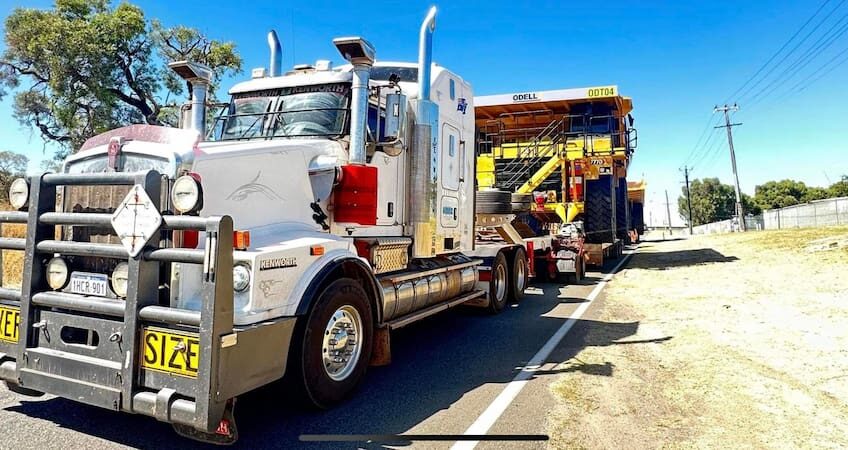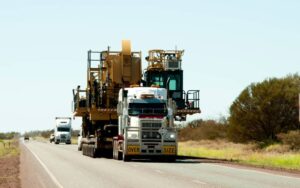
Mining trucks are essential for a range of industries across Australia, but have you ever wondered how these behemoth vehicles get from site to site? Well you’ve come to the right place to answer the question of “how are mining trucks transported?”
The mining truck transportation process is incredibly complex, involving extensive planning, permits, specialty equipment, and safety considerations.
As Australia’s heavy haulage experts, we’ve successfully and safely transported thousands of tonnes of mining equipment. In this guide, we’ll answer “How are mining trucks transported?” and explain some of the complexities involved in transporting heavy mining equipment.
Planning the Transport
Route Assessment
Evaluating road conditions and potential obstacles is the first step in transporting heavy mining equipment.
A thorough route assessment plan is necessary to designate an efficient route that will keep the equipment and driver safe and ensure timely delivery.
Route assessment will include evaluation of:
- Overhead restrictions
- Areas of construction
- The structural integrity of any bridges on the route
- Authorisation for any municipalities traveled through
- Telephone line lifting or power line de-energising
You May Also Like: 9 Benefits of Hiring a Heavy Haulage Company for Mining Equipment Transport
Permits and Regulations
Obtaining necessary permits and adhering to legal requirements is another key aspect of the mining truck transportation process.
Transport routes required a wide range of permits and licenses. It’s also necessary to know the legalities of each municipality or province the convoy passes through.
Our team is well-versed in complying with all steps of the legal transportation process and has a thorough understanding of which permits are needed and how to obtain them.
Preparing the Mining Truck for Transport
Disassembly and Preparation
With mind-boggling sizes of over 300 tonnes, giant mining trucks almost always require disassembly before transport.
How the truck is prepared for transport depends on the size of the mining truck, the haulage equipment, the loading and unloading areas, the destination, and the route.
Our modern line haul fleet and motivated team of highly qualified drivers evaluate all of these factors before deciding on the most cost-effective, safe method of transport.
Securing the Truck
Another crucial aspect of the mining truck transportation process is securing the mining truck to the trailer. Securing the truck involves various methods, depending on the size of the equipment, route, road conditions, and other considerations.
Transport Equipment and Safety Measures
Specialised Trailers
Transporting heavy mining equipment safely requires specialty trailers that are oversized and rated to haul immense mining trucks.
Our fleet is capable of handling any mining or heavy haulage requirements, even in remote locations. We’ve spent years successfully transporting heavy mining and earthmoving equipment to hundreds of sites all across Australia.
Load Distribution and Safety
Load distribution is another critical safety aspect when transporting heavy mining equipment.
We find this is an often overlooked area for companies who attempt to haul heavy equipment themselves. Even with all the right planning and properly rated equipment, uneven load distribution can cause everything from minor annoyances to life-threatening accidents and costly damage.
Our load distribution protocols exceed best practices in the industry and all of our team members are extensively trained in load distribution policies and protocols. We understand how to analyse load distribution to ensure the safest, most secure transport possible.
The Transport Process
Loading the Truck
Safely loading heavy mining trucks requires meticulous planning and attention to detail.
Our steps involved in safely loading the truck include:
- Strict safety precautions
- Rigorous training procedures for our staff
- Client education
- Ensuring individual site compliance
- Transparent and continuous communication with clients
- Detailed risk assessments to identify site-specific risks and potential hazards and implement safety protocols accordingly
- Designating a safe loading area that is level, clearly marked, free of objects or debris, and cleared of any staff or crew
- Having any crew members located in a safe place and wearing proper personal protective equipment
Learn more in our loading and unloading guide: Heavy Haulage: Expert Tips for the Safe Loading and Unloading of Equipment.
Monitoring During Transit
Safety checks and monitoring are crucial components of a seamless journey. At Australia Wide Haulage, all of our heavy haulage prime movers are equipped with satellite communication equipment.
This enables peace of mind throughout the transport and the ability for companies to monitor the exact location of their heavy equipment. This logistical support enables continuous monitoring throughout the transportation process
Our vehicles are specially made for the complexities of mining transportation. Each prime mover is equipped with satellite communication to enable steady communication, live location updates, and detailed monitoring.
Offloading and Reassembly
Safe Offloading
The mining truck transportation process doesn’t stop once we reach our destination. The offloading process is dangerous and requires meticulous planning and attention to detail.
We coordinate closely with all management and team leaders to keep an open line of constant communication. During unloading, we ensure your expensive mining equipment is unloaded safely and without damage.
Our #1 concern is always the safety of our crew and your crew. Since the diminished visibility makes the unloading process dangerous, we take extra precautions to ensure the safety of anyone involved.
Here are some tips for the safest unloading process:
- Keep any workers, obstacles, debris, and people clear of the offloading area — only designated crew members should be present
- Have clear signs indicating the offloading area
- Have a spotter present, if possible, to guide the mining transport driver
- Minimise vehicular traffic around the offloading area
- Schedule the offloading during a slower time of day when fewer staff members are present
- Be sure a safe distance is maintained between machinery and a spotter
- Notify all crew members of the loading and unloading schedule
- Designate a safe waiting place for on-site personnel
Reassembly at Destination
If mining equipment requires disassembly for transportation, it will be safely reassembled at the new destination. The reassembly process must happen quickly so operations are not delayed.
Transporting Heavy Mining Equipment? Entrust the Job to Australia’s Heavy Haulage Experts
There is zero room for error when transporting heavy mining equipment. Every detail of route planning, loading, load distribution, permits, unloading, and reassembly must all be completed perfectly.
Professional services are crucial for ensuring your heavy mining equipment is loaded, transported, and unloaded safely and on time.
We’re proud to be Australia’s premier choice for transporting mining trucks throughout the state and country.
Need expert help transporting heavy mining equipment safely and efficiently? Contact Australia Wide Haulage today to learn more about our specialised Mine & Remote Transport Services! We offer fast, no-obligation quotes for the transport of mining equipment, earthmoving equipment, and over-sized machinery to any site in Australia.

